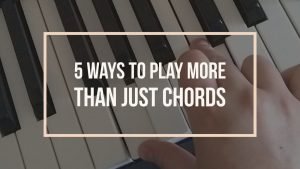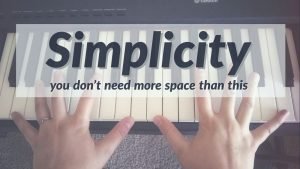Question: How do I play the piano fancier during worship songs? How do I play more than just a chord?
This lesson was requested by my wonderful Mom, who ironically is the one who first taught ME piano. Since then, 3 years of classical lessons and 15 years of contemporary worship team experience has multiplied the harvest she sowed in me. I'm excited to be able to finally give something back!
If you're like my Mom, you don't really practice outside of the worship team stuff. Even if you were to somehow find the motivation to sit down at the piano during the week, you would be lucky to practice for 15 minutes, 20 if you're lucky.
I get it. I've been there. This lesson is for you!

First, a note from history.
It used to be that most of the worship was sung and written at a piano or organ. Church songs and hymns were written with choirs in mind, embellished with grand melodies and complicated chords.
Most songs today are far simpler, repetitious, easy to sing, easy to learn, and may include an optional second or third part. Gone are the days of complex, grandiose, wordy music. I’m going to cover more of the history and culture behind this massive shift in another article.
Disclaimer: If you're playing piano for your church, keep in mind their culture, preferences, and background. What you are about to learn is a specific style for churches that prefer the contemporary worship of today. This is for churches that mostly play newer worship songs, have a full band, lead with guitar, or want to have a full guitar-led band. If you want to dress up your chords for hymn music and older worship songs, that's another lesson entirely.
If you're aiming for the modern contemporary style, don't feel pressured to play every part of the chord, a full base, and a flowery melody 100% of the time (unless you're playing traditional style hymns). The secret to dressing up your playing is, ironically, to play simpler music. It took me over a decade to discover these 5 tricks I know now. So here they are. I hope they help you as well!
Let’s do this.
LEARN TO SHARE
Are you playing by yourself for the worship service? With just a guitar player? In a full band? Hymns or modern music?
When you know the answer to that, you are able to determine what you should--and shouldn't--be playing on the piano.
There are 4 basic parts to a song:
Rhythm
Melody
Chords
Bass
As a piano player, you're more than capable of filling all those roles by yourself. But if you're in a band, you'll have to share the load a bit. Yay teamwork!
For example, if you have a bass player, go easy on your left hand. Let the bass player fill the role of playing bass.
If you have a drummer, no need to rock the beat. Let him lead the rhythm.
If the guitar is supposed to play mostly melody, support him by playing the basic chords. And vice-versa.
Stay around middle C, letting the melody instruments hang out on the higher notes and the bass hang out on the low notes.
If everyone plays everything, the song will sound chaotic and muddy!
So before you play a song, look around real quick and ask what parts are already being played. If the bass player is out sick, then add some more left hand.
A tricky situation you might run across is if the guitar is mostly leading rhythm and chords. What's you're supporting role then? How do I even match the guitar's unique groove without clashing? I struggled with this a lot at first. Don't worry! Stick around and I'll show you how I do it.
STAY NEAR MIDDLE C
Usually, you might think of the piano as having 2 sides: the left-hand side and right-hand side. That’s 44 notes for the left hand and 44 notes for the right hand. That can get overwhelming!
Your brain has a harder time keeping track of both hands when they're so far apart, playing very different roles.
So let's simplify things a bit.
Instead, think of the piano in this order: Bass, Middle C (melody/chord area), then High Notes.
Most of the time, all you need to play contemporary worship songs is about a 2-octave area around Middle C (maybe a little more). Everything outside of that area is optional. It's probably covered by another instrument anyway.
Now we have about 30 notes shared by both hands as your primary playing area. Much better!

Try this Instead:
Don't play a whole octave with the left hand (unless you're playing the role of bass). Alternatives: one note, a fifth, a seventh, a chord, or just breaking up the notes.
Only one hand needs to be playing a whole 3-note chord at a time. So what should your right hand do if your left-hand is playing a chord? Options: pick any two notes (a fifth, a third, C2, Csus, etc.) or play one note, break up the chord notes, or play a melody.
Be creative with it, keep it simple, and have fun!
Then send me a clip ;)
USE THIS SUPER EASY CHORD CHEAT
In most every guitar-based worship song, you’ll find that it is mostly a combination of 4 basic chords. In C, those would be C F G Am.
No matter what order those chords are being played, there are 2 universal notes that work for all of them.
I love playing these 2 notes for their beauty and simplicity. Especially for songs like “Shekinah Glory,” they make an amazing simple intro.
Here they are:
The 1 and 5 in the second inversion.
English, please?
Sorry.
Let’s say you’re playing the key of C. Here’s your basic chord: C+E+G
Instead of playing the whole chord, play C and G (leave out the second note). Any combination will do. My favorite is usually the second inversion: G then C.
Your left-hand plays a note at every chord change--usually some combination of C F G and Am.
Your right-hand stays in that sweet spot.
The result is this: F becomes F2, Am becomes Am7, G becomes Gsus.
Wow! Look at all those fancy chords!

In the key of A, for example, the two universal notes would be E and A. In the key of G, D and G. And so on.
This works in any key without fail. I'll usually start off with those simple notes and add more to it as the song builds.
LEARN FROM THE GUITAR
I was fresh out of taking advance classical piano lessons, super pumped up about joined our local church worship team. This was the perfect place to use my brand new skills for God’s glory!
But at every single practice, it was the same thing: “Don’t play so much. The classical is clashing with the music.”
I scratched my head. How is it too much? I’m on key, I’m accurate, it fits the song, it embellishes the singers, it flows with the mood. I'm even playing in the correct rhythm! What’s wrong with my fancy playing? Are they just prejudice against classical?
No matter how hard I tried, nothing worked. I wasn’t getting it.
Then it hit me.
The piano is not the lead instrument here. The guitar is.
This was mind-blowing news to me! My Dad has stopped pastoring after 13 years, pretty much my whole life at that point. We always had Mom at the piano and sang combinations of hymns and “new songs.” For the first time in my life, my full skills had to take a backseat.
But how do I play something that will blend well with the guitar?
There was only one thing left to try. I thought, "If they want the guitar, then the guitar is what they'll get!"
I watched the lead guitar very closely, following his hand strokes. And it worked! I’ve never had a complaint since then.
Here's a video walkthrough of how I do it:
This isn't the only way of doing it, though. You can try asking a guitar player to play for a while so you can experiment with the rhythm yourself.
Again: be creative, keep it simple, have fun.
LEARN THE SCALES
Okay, okay, I know I promised that this wouldn't take much practice. It still won't, trust me (but if you can take the time to memorize and play all the scales flawlessly, please do!).
Why scales? That's so boring!
Firstly, you only need to learn them in your right hand. If you can manage both, that's awesome! But your right hand is fine for now. Here's a simple walkthrough.
Secondly, how many different keys does your worship team play in? It can't be that bad, can it? My last guitar worship leader played everything in E, G, or D.
Thirdly, you will be amazed at the results. It's time to unleash your true potential!
Here's a little secret:
Come closer.
Closer.
You can play any note in the scale, no matter what chord is being played, and you will never sound bad.
Yup.
Yeah, you're getting it now! You can play any fancy melody to your heart's content and will never mess it up! Didn't think it could be that easy, did you?
I get compliments all the time for how pretty my playing is. Literally, all I would be doing is maybe a chord in the left hand and randomly pounding notes in the scale with my right. I'm not kidding. If it were just any note, I would sound like a 2-year-old. But since its just within the scale I sound like a professional.
I guess we're done now. You're probably itching to go try this stuff out. Alright then, get outa' here and have fun!
Was this helpful? Have another question? Ask away! This article is also available at heavennaturesing.com/piano-lesson-beyond-chord.